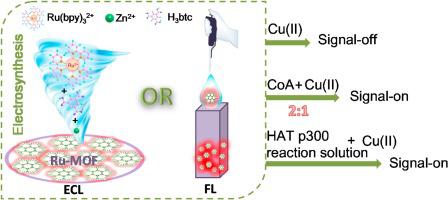Sensors and Actuators B: Chemical ( IF 8.0 ) Pub Date : 2020-09-12 , DOI: 10.1016/j.snb.2020.128896 Dandan Hu , Tianyu Zhan , Zhiyong Guo , Sui Wang , Yufang Hu

|
A novel dual-modality readout biosensing method is developed for Cu(II), coenzyme (CoA) and histone acetyltransferase (HAT) analysis based on an electrosynthesized tris(bipyridine)ruthenium(II)-functionalized metal-organic framework (Ru-MOF). In this protocol, the Ru-MOF with a delicate structure serves as both an electrochemiluminescent (ECL) and fluorescent (FL) probe. Interestingly, Cu(II) can hinder the two distinct processes favorably, thus realizing bidirectional detection of Cu(II) via an “on-off” method. Simultaneously, CoA, which contains a sulfhydryl group, can ignite a reverse “off-on” process due to the polymeric interaction of CoA and Cu(II) (2: 1). Similarly, abundant CoA molecules could also be generated regularly by a typical HAT p300-driven acetylation reaction, hence accomplishing HAT p300 activity analysis. Subsequently, an ingenious “on-off” route is exhibited again by the introduction of some small molecules (including anacardic acid and C646), which present an inhibiting effect on HAT p300 activity. Furthermore, quantitative analysis of Cu(II), CoA and HAT p300 (ECL/FL) is achieved brightly with detection limits of 0.19/0.76 nM, 1.3/6.5 nM and 1.5/8.8 nM, respectively. Ultimately, this two-channel biosensor with excellent analytical performance is applied successfully in real samples, demonstrating its potential use in bioanalysis.
中文翻译:

电合成的金属有机框架:用于铜(II),辅酶A和组蛋白乙酰转移酶分析的双峰读数平台
基于电合成的三(联吡啶)钌(II)-功能化的金属-有机骨架(Ru-MOF),开发了一种新颖的双模态读出生物传感方法,用于Cu(II),辅酶(CoA)和组蛋白乙酰转移酶(HAT)分析。在该协议中,具有精细结构的Ru-MOF既可用作电化学发光(ECL)探针,又可用作荧光(FL)探针。有趣的是,Cu(II)可以很好地阻碍这两个不同的过程,从而实现了通过一种“开关”方法。同时,由于CoA与Cu(II)(2:1)的聚合相互作用,包含巯基的CoA可以引发反向的“关闭”过程。同样,也可以通过典型的HAT p300驱动的乙酰化反应定期生成大量CoA分子,从而完成HAT p300活性分析。随后,通过引入一些对HAT p300活性具有抑制作用的小分子(包括漆树酸和C646),再次展现出巧妙的“开-关”路线。此外,在检测限分别为0.19 / 0.76 nM,1.3 / 6.5 nM和1.5 / 8.8 nM的情况下,可以很好地完成Cu(II),CoA和HAT p300(ECL / FL)的定量分析。最终,这种具有出色分析性能的两通道生物传感器成功应用于实际样品中,











































 京公网安备 11010802027423号
京公网安备 11010802027423号